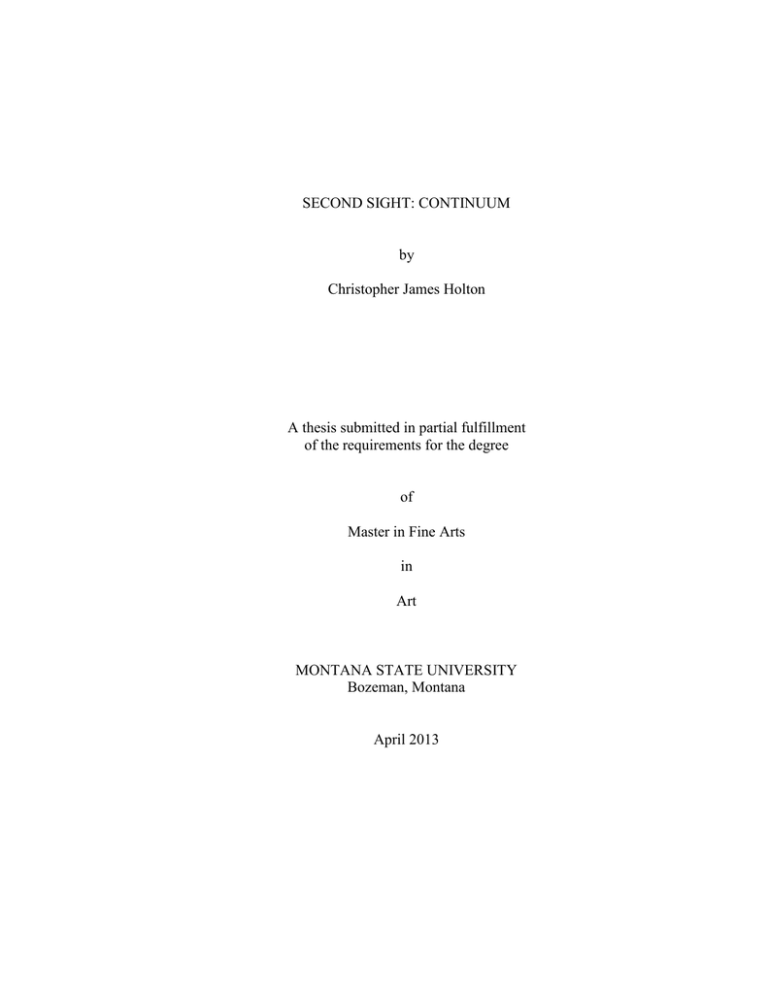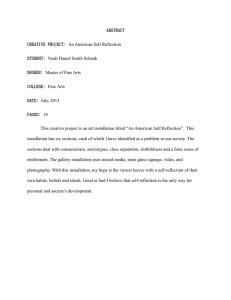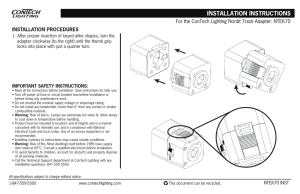SECOND SIGHT: CONTINUUM by Christopher James Holton
advertisement

SECOND SIGHT: CONTINUUM by Christopher James Holton A thesis submitted in partial fulfillment of the requirements for the degree of Master in Fine Arts in Art MONTANA STATE UNIVERSITY Bozeman, Montana April 2013 ©COPYRIGHT by Christopher James Holton 2013 All Rights Reserved ii APPROVAL of a thesis submitted by Christopher James Holton This thesis has been read by each member of the thesis committee and has been found to be satisfactory regarding content, English usage, format, citation, bibliographic style, and consistency and is ready for submission to The Graduate School. Dean Adams Approved for the School of Art Vaughan Judge Approved for The Graduate School Dr. Ronald W. Larsen iii STATEMENT OF PERMISSION TO USE In presenting this thesis in partial fulfillment of the requirements for a master’s degree at Montana State University, I agree that the Library shall make it available to borrowers under rules of the Library. If I have indicated my intention to copyright this thesis by including a copyright notice page, copying is allowable only for scholarly purposes, consistent with “fair use” as prescribed in the U.S. Copyright Law. Requests for permission for extended quotation from or reproduction of this thesis in whole or in parts may be granted only by the copyright holder. Christopher James Holton April 2013 iv LIST OF IMAGES Images Page 1. Installation View, Pedestals ...............................................................................12 2. Installation View, Pedestals ...............................................................................12 3. Installation View, Pedestals ...............................................................................13 4. Detail – Installation View, Pedestals .................................................................14 5. Detail – Installation View, Pedestals .................................................................15 6. Installation View, Exterior .................................................................................16 7. Installation View, Exterior .................................................................................16 8. Installation View, Exterior .................................................................................17 9. Installation View, Interior – Room #1 ...............................................................17 10. Installation View, Interior – Room #1 .............................................................18 11. Installation View, Interior – Room #1 .............................................................19 12. Installation View, Interior – Room #1 .............................................................19 13. Installation View, Interior – Room #1 .............................................................20 14. Installation View, Interior – Room #1 .............................................................20 15. Installation View, Interior – Room #1 .............................................................21 16. Installation View, Interior – Room #1 .............................................................21 17. Installation View, Interior – Room #2 .............................................................22 18. Installation View, Interior – Room #2 .............................................................22 19. Installation View, Interior – Room #2 .............................................................23 20. Installation View, Exterior ...............................................................................23 v ABSTRACT The speed and transcontinental abilities of sophisticated telecommunications impact our physical and physiological being within cultural structures. The developments of certain technologies have continued to push the boundaries of the conceptual transfiguration of a person’s perception of space and reality, manipulating our senses and assaulting our feeling of corporeality. Through my installation, I present the viewer with multiple modes of telecommunications, allowing the viewer the options of being an active participant in their experience, or become a passive spectator. I aim to challenge the individual to discover a higher awareness to their physical being through social-technological interaction, and question the ethical responsibility of social-political structures implementing these given technologies. 1 The phenomenology of “real” and “virtual” presences and the agency involved in experience through communication have consistently been conceptual touchstones for my work. What has changed in my approach to such issues is the way in which I frame my inquiry. Instead of asking, “What is my relationship with ‘real’ and ‘virtual’ spaces” I am now asking, “What is the cause of this relationship in question?” This transfer of perspective has led me down a path seeking to understand the modes of interactions I engage in and how space (both physical and virtual) and speed (transmission and reception) affect the gap between tools of communication and the human implementation of those tools, and ultimately how this contributes to our definition of "reality". The use of modern telecommunications has shaped our social structure and how we engage with other individuals in social-political spaces. It has also allowed the “telepresence” (or pseudo-presence) of an individual through the “space” (space/not-space) of the electronic screen. We can interact with individuals from all different areas of the world simultaneously, allowing business to be carried out instantaneously. What do we stand to lose; both conceptually as well as corporeally, through this accelerated telepresence, and how will that translate to the interactions within the social-political spaces? My work has recently employed a variety of telecommunication devices to present the viewer with the appearance of a dialectic encounter between passivity and agency in the experience of communication. I utilize sculptural forms (pedestal and televisions) that retain their behavior as objects of one-way communication, i.e., to "stage" the reception of the visual and audio components of the television in the context of an art experience, an event that takes place within the gallery setting. This work is 2 juxtaposed with current, interactive software that allows us two have a two-way form of communication, i.e. transmission and reception. An abiding interest of mine is to demonstrate or implicate how our interactions with these technologies can help us understand the possible effects these devices may have on our sense of physical self and our experiences of the real through physical engagement, investigating the possible dangers, confusion, and phenomenological effects these “extensions” to our senses might represent in other social-political constructs. Space, Speed, and the Nature of the Tele-Human Relationship I believe the speed, space, and nature of the telecommunication tools has a significant affect on our sense of material existence. Corporeality is characterized by the presence of a physical being. We use our sense of physicality as an indicator of “real” space, which we give priority in the hierarchy of spatial existences. What effects do the use of telecommunications have on our perception of physical, tangible space, as well as our organization of social-political constructs, change through the use of these technologies? One of the first artists who investigated the accelerating media “landscape” as a medium for cultural discourse was Nam Jun Paik. He has been quoted as saying “Skin has become inadequate in interfacing with reality. Technology has become the body's new membrane of existence.” 1 Nam Jun Paik was a pioneer of video 1 Nam June Paik, 2010, http://namjunepaik.wordpress.com/2010/05/04/nam-june-paik-electronic-expressionanalytical-essay/ 3 sculpture/installation art. His work spanned the mid to late 20th century and covered politics, social structures, and media consumption, all of which he portrayed extensively through video art. I share the same sentiment as Nam Jun Paik in regards to his quote. The separation of technology and the experience of reality have become blurred, possibly indiscernible. Telecommunications allow us to interface by using a transmitter, the communicative screen. The television screen is an object occupying a real space, but at the same time it depicts an image, an image that becomes a non-space. I believe we can compare the attributes of the computer to the function of the mirror. They both have the ability to “reflect” a real space. Michel Foucault refers to the telecommunication screen as heterotopias, a space of existence and non-existence. Foucault states: The mirror is, after all, a utopia, since it is a placeless place. In the mirror, I see myself there where I am not, in an unreal, virtual space that opens up behind the surface; I am over there, there where I am not, a sort of shadow that gives my own visibility to myself, that enables me to see myself there where I am absent: such is the utopia of the mirror. But it is also a heterotopia in so far as the mirror does exist in reality, where it exerts a sort of counteraction on the position that I occupy. 2 `One of Foucault’s arguments was that space, specifically heterotopias, are a central source of anxiety in the contemporary era. I believe this anxiety is caused by the constant concurrence of the “real” and “virtual” presence with an ability to navigate, from one to the other without smooth transitions, a time of decompression if you will. This same type of anxiety continues as we develop technologies of speed, transportation, and telecommunications. We can extrapolate this anxiety into our physical and psychological interactions. If the screen becomes the popular mode of communication, the televised 2 Foucault, Michel. "Of Other Spaces," Diacritics 16 (Spring 1986), 22-27. 4 image becomes a valid index of existence. These interactions contribute to an increased emotional anxiety within our culture, and they are exasperated by the speed (nature) of technology. The speed of technological advancements has continued to push the boundaries and possibilities of media communication. We are culturally engulfed with the concept of “speed.” Whether it is quantitative speed, measuring the movement across a distance over time, or symbolic speed, in reference to the “speed” of life, speed has become a defining point for establishing positive and negative aspects of human activity. Paul Virilio, a French theorist who gained prominence towards the later part of 20th century is highly regarded for his writings on speed and power. Paul Virilio illustrates the concept of speed (light interval) in regards to telecommunication by stating the following: Indeed, the question of the real instant of instantaneous teleaction raises once again the philosophical and political problems traditionally associated with the notions of atopia and utopia, and promotes what is already being referred to as a teletopia, with all the numerous paradoxes attendant on this such as: Meeting at a distance, in other words, being telepresent, here and elsewhere, at the same time, in this so-called ‘real time’ which is, however, nothing but a kind of real space-time, since the different events do indeed take place, even if that place is in the end the non-place of teletopical techniques (the man-machine interface, the nodes of packetswitching exchanges of teletransmission). 3 This helps illustrate the ideal effect of the speed of communication and the lack of transitory time that is involved in telecommunications. The fact that we can 3 Virilio, P. Open Sky. New York, NY: Verso, 2008 p. 10. 5 communicate with another individual from a completely different real space and commit to a non-space instantaneously is what I believe is another part of the assault on our sense of physical perception. I theorize that the nature of the relationship between humans and tools of technology is what I believe is the culmination of understanding our departure from the traditional sense of corporeality and embracing the capabilities of the telecommunication system at face value. I believe the nature of our relationship with technology can be called a symbiosis. Adam Swift is the first individual who I found successfully explains the symbiosis of technology-human association. Symbiosis is commonly used in describing a type of connection between two different types of organisms in biological terms. Adam Swift takes the research of John Maynard Smith, a biologist and geneticist who breaks down symbiosis to three distinct relationships, and applies them to a human-technology relationship. The three affairs are commensalism, helotism, and mutualism. When discussing the characteristics of each type of relationship, I believe the best one that represents media communication and humans is helotism. Swift’s definition and example of helotism is: Helotism: one species is held to the benefit of the other as if it were a slave. Examples of such relationships can be seen in either direction. While the human uses indentured technology in order to achieve numerous tasks, technology can often been seen to enslave or delimit human activity. 4 The ideas of technology and in this case a telecommunications-human relationship, as a helotism is plausible. We can use the cinema as an event to investigate how 4 Swift, A. (2006) Mapping posthuman discourse and the evolution of living information, Retrieved from www.eprints.qut.edu.au/ 6 telecommunications can be a hindrance to human activity, and support the concept of a symbiotic relationship between people and technology. The cinema screen acts like a magnet to our senses; its primary goal is for visual stimulation by engaging us with a dark void and a bright light placed in front of the space, a typical hierarchical format. The audio produced for the film is as poignant as the visual, causing the viewer to have a focused sense of perception and a restricted sense of awareness. We can see this process of being at the cinema as a hypnotic experience. The perception is you are physically absent to the rest of the space; your hyper-focused sense of sight and sound has taken precedence over spatial awareness. Technology has proven it can reduce the scope of physical perception by engaging the individual’s ability to focus on various events by strongly activating various senses. The nature of the courtship between technology and humans and the space and speed of telecommunications has all played a part in desensitizing our realization of our physical presence or existence. This is largely due to how these tools of connectivity create various layers of reality, and the combination of these realities play a part in shaping our senses and how we interact in a hyper-reality, the combination of all of these layers. Second Sight: Continuum The goal of Second Sight: Continuum is to present various modes of communication to activate the viewers’ awareness of their physical being in a public 7 space of communication. My understanding of the space, speed, and nature of these technological devices help me facilitate this process as an artist. The first piece turns out to be a type of homage to Nam Jun Paik’s work with the consumption of media. There are two pedestals facing each other, roughly six feet tall, enclosed with three televisions. I have set this piece up to be a representation of a communicative process, one where there is an object of transmission, and we become the receiving object of that transmission. The viewer is engulfed by the form, light, and sound coming from the sculpture. This is my way of presenting the viewer with a telecommunication process that can leave a person immobile and fixated upon the image, something comparable to the event of the cinema. This sculpture reflects the sentiment expressed by Robert Smithson, a prominent land artist of the 60’s, with regard to the event of the cinema. He believed the act of being in a cinema was a “hypnotic” process for the mind, and a “disabling” of the body. 5 My first piece aims to relive, or experience the negative components of this incident. I feel this is required to validate and counter the rest of the installation to entice a sense of self-criticality towards our participation in communicative process in and its possible implications in social-political constructs. The rest of the installation takes cues from Roland Barthes and his alternative way of breaking down the familiarity of video systems. Roland Barthes believed the encounter of the cinema needed to be more than a narrow experience of sensory stimulation. The experience should include the visual space of the theater, the ambient 5 Bishop, C. Installation Art A Critical History. New York, NY: Routledge, 2005. p. 94. 8 sounds, and the ambient light that encompass the whole space of the cinema, not just the screen. 6 If the spectator takes this knowledge of total sensory consumption, then they have the ability to be active agents in the installation. The viewer navigates their way through the work, which is highly guided by a large curvilinear structure in the gallery. This wall functions as an obstacle of navigation, and a barrier for splitting of various viewing areas. This form is partially influenced by Richard Serra’s large steel plate sculptures. What I agree most with Richard Serra’s practice is his belief in the role of the gallery patron as an object, specifically an article of communication between the relationship of the constructed space and the viewer. I believe the use of these various technologies enhances this concept of the patron becoming the “object” in the gallery, replacing the traditional notion of the artwork serving as the subject of contemplation. I designed the space to be an "interactive" event, void of anything besides the viewer, the walls, and a projection. I believe it is now the role of the viewer to become the object of conversation as well as the subjects of interaction. Their level of participation in the first large area relates to their movement in the space. The viewer moves in front of a large projection in which it changes color based upon their movement. The viewer is in control of the intensity of his or her own visual experience within the parameters that I have set for the installation. There is a dichotomy of the control a person feels to possess, and the actual control they have within the space. 6 Bishop, C. Installation Art A Critical History. New York, NY: Routledge, 2005, p. 95. 9 As the individual navigates around the wall structure, and enters the other half of the gallery, they are presented with a similar scenario. Now they enter the place with a sense of continuing agency, as if they know there physical movement will become a part of their visual practice. But this is not the case, and instead, they are presented with a space in which their physical movement is not the interactive part. This portion of the installation is affected by the sounds created within location. The sound of movement, conversations, and ambient noise are all picked up and transformed into a reactive visual projection. The entire installation experience is then finalized through exiting the space, a physical transition from the inner gallery to the outer section. During this transitory experience, we hear recorded audio that is slightly delayed and presented back to us. In further reference to the assertions of Virilio, the idea of the speed of telecommunications and its capabilities creates an uneasy experience of past time that is qualified at the instantaneous moment. Just like the idea of the computer screen reflecting back on us as a non-space, the audio represented exists in a non-space. This event is purposely delayed to allow us to separate the acts of communication, the “real” space occurrence, versus the “virtual” space of the delayed auditory affair. The possibilities of this event, the interactive projections, and sculpture seek to implicate and call into question the way we engage with telecommunications. Technology informs (our perceptions of) reality. We are first presented with a physical reality, our existence in space, and then a virtual reality, a space of teletopia. The virtual becomes validated through experience, and pushes us to a realm of hyper-reality, or 10 surreality. Our sense of corporeality changes when this occurs, and this may be perceived as a negative departure. This requires us to analyze the potential ethical contours and problems underpinning the application and control of telecommunications within socio-political and cultural structures. I believe surveillance is one piece of technology used by the state apparatus that enables a greater power of control by conveying a sense of immanent presence. The surveillance camera as a tool of communication has two functions, one is to perform a technical task of recording or transmitting a video of the space it is monitoring, the other is to serve as a symbolic gesture of power, control, subordination, and possible fear. The technology allows the state apparatus to have a presence without a physical being; it is successfully the first panoptical device. The ethical problem at hand is one of power and deception. The deceptive, pervasive nature of surveillance is why there should be a question of the ethical responsibility of applying these tools. If we lose a sense of corporeality, or begin to meld the layers of reality, losing the reference of a hierarchy of spaces, how does technology affect the relationship of the state apparatus and its subjects? Through my audio/video installation I hope participants will begin to investigate the possible dangers, confusion, and phenomenological effects these “extensions” to our senses might have. Social-political institutions will continue to utilize telecommunications and there should be a continuing inquiry of what the ethical responsibilities of these constructs are. 11 Works Cited Bishop, C. Installation Art A Critical History. New York, NY: Routledge, 2005. Print. Foucault, Michel. "Of Other Spaces," Diacritics 16. (Spring 1986): Print. Nam Jun Paik, 2010, http://namjunepaik.wordpress.com/2010/05/04/nam-june-paikelectronic-expression-analytical-essay/ Swift, A. (2006) Mapping posthuman discourse and the evolution of living information, Retrieved from www.eprints.qut.edu.au/ Virilio, P. Open Sky. New York, NY: Verso, 2008. Print. 12 Image 1 – Installation View, Pedestals Image 2 – Installation View, Pedestals 13 Image 3 – Installation View, Pedestals 14 Image 4 – Installation View, Pedestals - Detail 15 Image 5 – Installation View, Pedestals - Detail 16 Image 6 – Installation View, Exterior Image 7 – Installation View, Exterior 17 Image 8 – Installation View, Exterior Image 9 – Installation View, Interior – Room #1 18 Image 10 – Installation View, Interior – Room #1 19 Image 11 – Installation View, Interior – Room #1 Image 12 – Installation View, Interior – Room #1 20 Image 13 – Installation View, Interior – Room #1 Image 14 – Installation View, Interior – Room #1 21 Image 15 – Installation View, Interior – Room #1 Image 16 – Installation View, Interior – Room #1 22 Image 17 – Installation View, Interior – Room #2 Image 18 – Installation View, Interior – Room #2 23 Image 19 – Installation View, Interior – Room #2 Image 20 – Installation View, Exterior





